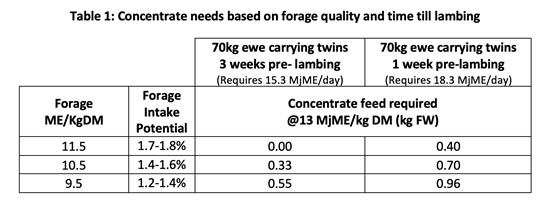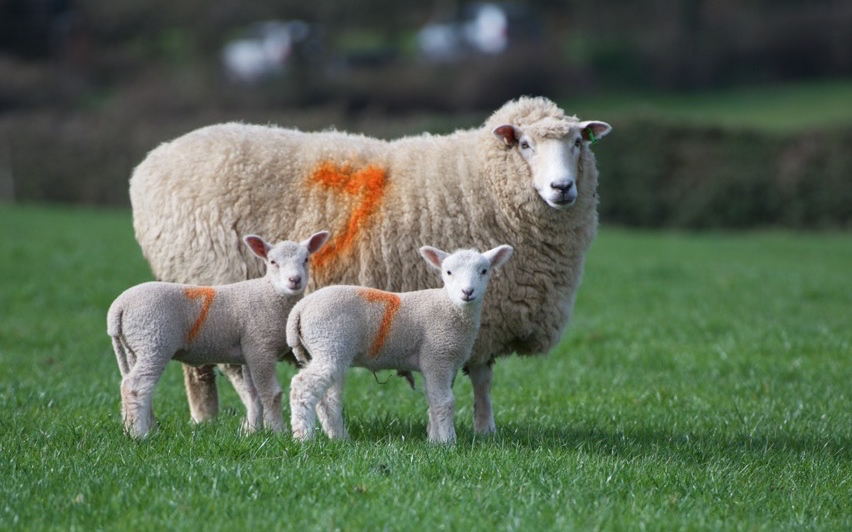If ewes aren't provided with adequate nutrition at this time then they can suffer with poor body condition and milk yield and colostrum quality can be reduced, with lambs potentially suffering from poor immunity. This can result in smaller, weaker lambs that are slower growing and more susceptible to disease. Alternatively, ewes that are too fat have increased risk of prolapse and twin lamb disease, which can lead to lambing difficulties.
Ensure adequate energy and protein
The last six weeks prior to lambing are probably the most important of the year. In this period the foetus is growing, taking space in the abdomen away from the rumen and reducing the ewe’s daily dry matter intake (DMI), while energy and protein demands are increasing to cover the growth of the lambs. Indeed, 70 per cent of a lamb’s birthweight will be put on in the last six weeks before birth, and she also must develop udder tissue and produce colostrum during this time.
In fact, the ewe’s nutritional needs will often double during the last six weeks prior to lambing (depending on how many lambs she is carrying), yet intakes are usually depressed.
This is the key reason why scanning is recommended. Ewes should be grouped according to how many lambs they are carrying, with feed provision then being adjusted accordingly. Weighing ewes on a regular basis, as well as routine body condition scoring, can be very helpful in determining the appropriate feeding level, as outlined in the table below:

Providing a high-quality forage source is very important, as feed costs make up a significant proportion of the total costs in a sheep flock. Maximising the use of high-quality forage can help to reduce the quantity and quality of purchased concentrate feed required, saving money. It is important to get forage analysed, as this provides a starting point to base ration formulation upon.
An example of the impact forage quality has on concentrate supplementation required is shown below:

When it comes to protein, the amount of microbial protein produced in the rumen of the ewe is crucial. Ensuring the rumen is functioning at an optimum level is, therefore, very important, as it will increase the amount of microbial protein. In the last few weeks before lambing, when space is limited and the demands for colostrum and milk production are increasing, there is a greater need for a higher quality, higher DUP protein source, such as soya.
A concentrate feed should be chosen based on the quality of forage available on the farm. In most cases, using a higher specification concentrate will mean that less needs to be fed, reducing costs. This means forage utilisation will be better, not only improving the health of the ewes, but also reducing feed costs overall for the farm. What’s more, lambs will be born with more vitality and will grow faster earlier in life.
Typically, high quality concentrates will include a high proportion of cereals, which will drive rumen digestion and stimulate glucose production, which is necessary for foetal growth and colostrum production and when in short supply leads to twin lab disease. Concentrates should also have a good quality protein – around 10% soya typically – and contain 150mg/kg of Vitamin E and 0.5mg/kg Selenium.
Don't forget water…
As with other ruminants, water is extremely important in sheep. Sheep prefer fresh, clean water. Intakes of water increase dramatically as ewes lamb and it is essential that sufficient clean water is available at all times.
How you feed is as important as what you feed…
Ensure good access to feed. On an ad-lib forage system, there should be approximately 15cm of feed space per ewe. This may mean feeding between pens as well as in front of pens.
If feeding concentrates, then at least 45cm of feed space per ewe is required. One solution for feeding ewes is to scatter the concentrates on the floor (if the bedding is clean and dry). This encourages exercise, as well as slowing down intakes, but also increases access to feed for all ewes in a pen. This has been shown to reduce prolapses in ewes.
If significant quantities of concentrate feed are being fed, then it is best practice to split this over 2 or 3 feeds a day to minimise acidosis risk. Feeding less of a better-quality concentrate will pay, not only with reduced feed costs overall but also reduced health issues, including fewer cases of twin lamb disease, prolapses, watery mouth, and a lower worm burden post-lambing.
Acidosis risk
Remember, optimising rumen health is key. Feeding too much concentrate reduces the pH of the rumen, which impacts on digestive efficiency. Rapid transition between different rations can also lead to digestive upset.
The aim should be to maximise forage intake and supplement (not substitute) with concentrate as required.
Supplement with Actisaf® and Safmannan® to deliver better results
Feeding Actisaf® live yeast to ewes stabilises rumen pH by reducing the build-up of lactic acid in the rumen, which causes acidosis. It also increases volatile fatty acid (VFA) production and microbial protein synthesis, both of which increase milk yield and quality. Furthermore, Actisaf® reduces rumen oxygen content, stimulating the growth of beneficial microbes that digest fibre and convert lactic acid to propionate which, when deficient in ewes, can lead to twin lamb disease.
Other benefits of feeding Actisaf® include:
- Increased feed intakes
- Reduced risk of rumen acidosis and poor digestion
- Up to 20% higher milk yield
In addition, adding Safmannan premium yeast fraction to ewe rations delivers real benefits in supporting the immune system of the ewe around lambing time, when she is under the most stress.
Adding Safmannan and Actisaf to a good quality concentrate will benefit ewes and ensure maximum performance and results on farm at this crucial time of the year.

